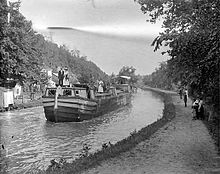In early March 1825, President James Monroe signed the bill chartering the construction of the C&O Canal as one of the last acts of his presidency.[5]The plan was to build it in two sections, the eastern section from the tidewater of Washington, D.C., to Cumberland, Maryland; and the western section over the Allegheny Mountains to the Ohio River or one of its tributaries. Free from taxation, the canal company was required to have 100 miles in use in five years, and to complete the canal in 12 years.[6] The canal was engineered to have a 2 mph water current, supplying the canal and assisting mules pulling boats downstream.[7]
The eastern section was the only part to be completed[8]
In October 23, 1826, the engineers submitted the study, presenting the proposed canal route in three sections. The eastern section comprised Georgetown to Cumberland; the middle section, Cumberland (going up Wills Creek to Hyndman then across the Sand Patch Grade crossing the Eastern Continental Divide to Garrett[9]) to the confluence of the Casselman Riverand the Youghiogheny River; and the western section from there to Pittsburgh.[10]
| Section | Distance | Ascent & Descent | # of Locks | Cost |
|---|---|---|---|---|
| Eastern | 185 Mi 1078 Yds | 578 Feet | 74 | $8,177,081.05 |
| Middle | 70 Mi 1010 Yds | 1961 Feet | 246 | $10,028,122.86 |
| Western | 85 Mi 348 Yds | 619 Feet | 78 | $4,170,223.78 |
| Total: | 341 Mi 676 Yds | 3158 Feet | 398 | $22,375,427.69 |
The total estimated price tag, more than $22 million, dampened the enthusiasm of many supporters, who were expecting more like $4 million to $5 million. At a convention in December 1826, they attempted to discredit the engineers' report, and offered lower estimates: Georgetown to Cumberland, $5,273,283; Georgetown to Pittsburgh, $13,768,152.[10] Geddes and Roberts were hired to make another report, which they gave in 1828: $4,479,346.93 for Georgetown to Cumberland.[11] With those numbers to encourage them, the stockholders formally organized the Chesapeake and Ohio Canal Company in June 1828.[12] In the end, the final construction cost to Cumberland in 1850 was $11,071,075.21. Compared to the original cost given by the engineers in 1826 of about $8 million, removing things not in the estimate such as land purchases, engineering expenses, incidental damages, salaries, and fencing provision, the cost overrun was about 19%, which can be justified by the inflation rate of the period. The cost overrun of the other proposal (Geddes and Roberts) was about 51%[13] thus showing that the original engineer's estimate was good.
In 1824, the holdings of the "Patowmack Company" were ceded to the Chesapeake and Ohio Company. (Rejected names for the canal included the "Potomac Canal" and "Union Canal".[14]) By 1825, the Canal Company was authorized by an act of the General Assembly of Maryland in the amount of subscriptions of $500,000 authorized by the act of incorporation paved the way for future investments and loans. According to historians,[15] those financial resources were expended until the State had prostrated itself on its own credit.
Groundbreaking[edit]
The C&O's first chief engineer was Benjamin Wright, formerly chief engineer of the Erie Canal. A groundbreaking ceremony was held on July 4, 1828, attended by U.S. president John Quincy Adams. The ceremony was held near Georgetown, at the canal's eventual 5.64-mile mark near Lock 6, the upstream end of the Little Falls skirting canal, and Dam No. 1.[16][17]
At the groundbreaking, there was still argument over the eastern end of the canal. The directors thought that Little Falls (at the downstream end of the Patowmack Little Falls Skirting Canal) was sufficient since that literally fulfilled the charter's condition of reaching the tidewater, but people in Washington wanted it to end in Washington, connecting to the Tiber Creek and Anacostia river.[18] For that reason, the canal originally opened from Little Falls to Seneca, and the next year, was extended down to Georgetown.
The Little Falls skirting canal, which was part of the Patowmack Canal, was dredged to increase its depth from four to six feet, and became part of the C&O canal.
The first president of the Canal, Charles F. Mercer, insisted on perfection since this was a work of national importance. This would cost the company more money to build the canal. During his term, he forbade the use of slackwaters for navigation or the use of composite locks (see section below) or reduction of the cross section of the canal prism in difficult terrain. The reduced maintenance expenditures but increased construction costs.[19] In the end, two slackwaters (Big Slackwater above Dam #4, and Little Slackwater above Dam #5) and composite locks (from Lock 58-71) were built.
At first, the canal company thought to use steamboats in the slackwaters, since without mules, the canal boats had to use oars to move upstream, having no motive power. After many complaints of delays and dangers, the company provided a towpath so that the mules could pull the boats through the slackwaters.[20]
Section numbers and Contracts[edit]
From Lock 5 at Little Falls to Cumberland (as mentioned above, the canal started at Little Falls, and was later extended down to Georgetown), the canal was divided into three divisions (of about 60 miles apiece), each of which was further divided into 120 sections of about one-half mile. A separate construction contract was issued for each section.[21] Locks, culverts, dams, etc. were listed on the contracts by section number, not by mileage as is done today. For instance, Locks 5 and 6 are on Section No. 1,[22] all the way to Guard Lock #8 on section 367.[23]Sections A-H were in the Georgetown level below lock 5[22]

No comments:
Post a Comment